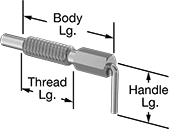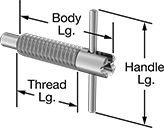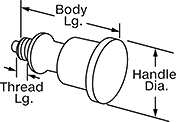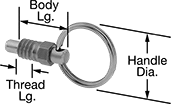Filter by
Thread Size
Nose Material
Extended Nose Force
Compressed Nose Force
Locking Type
Mount Type
Body Material
Thread Type
Drive Style
Handle Material
Performance
Plunger Locking Type
DFARS Specialty Metals
Export Control Classification Number (ECCN)
Long-Nose Spring Plungers
 |
 |
Lock heavy moving parts securely in place. Often used in indexing applications, these have a longer nose than ball-nose spring plungers to withstand greater side forces without disengaging. The nose compresses when a part presses against it, and then pops out into deep notches or grooves for a strong hold.
Spring plungers are available with or without a threadlocker. Those with a threadlocker won't wiggle loose from vibration. Spring plungers without a threadlocker are easier to remove.
Steel Nose—The strongest, most wear-resistant noses, these won't deform from stress and vibration. Steel is best for dry environments, however, since moisture will cause it to rust.
18-8 Stainless Steel Nose—The choice for wet and outdoor environments, 18-8 stainless steel resists rusting. It's strong enough for most jobs, but won't withstand stress and vibration as well as steel.
Acetal Nose—The best plastic for damp and wet environments, acetal won't swell or lose strength if exposed to moisture. These noses are extra soft to avoid scratching delicate surfaces. They are best for use on soft materials, such as aluminum.
Spring Plungers | Spring Plunger Drivers | ||||||||||||||||||||||||||||||||||||||||||||||||||||||||||||||||||||||||||||||||||||||||||||||||||
|---|---|---|---|---|---|---|---|---|---|---|---|---|---|---|---|---|---|---|---|---|---|---|---|---|---|---|---|---|---|---|---|---|---|---|---|---|---|---|---|---|---|---|---|---|---|---|---|---|---|---|---|---|---|---|---|---|---|---|---|---|---|---|---|---|---|---|---|---|---|---|---|---|---|---|---|---|---|---|---|---|---|---|---|---|---|---|---|---|---|---|---|---|---|---|---|---|---|---|---|
Nose, mm | Nose Force, lbf | Body | |||||||||||||||||||||||||||||||||||||||||||||||||||||||||||||||||||||||||||||||||||||||||||||||||
Thread Size | Extended Lg. | Wd. | Dia. | Extended | Compressed | Material | Lg., mm | Drive Style | Each | Each | |||||||||||||||||||||||||||||||||||||||||||||||||||||||||||||||||||||||||||||||||||||||||
Steel Nose | |||||||||||||||||||||||||||||||||||||||||||||||||||||||||||||||||||||||||||||||||||||||||||||||||||
| M16 x 2 mm | 8 | — | 7.87 | 10.4 | 25.3 | Black-Oxide Steel | 38 | Spring Plunger Driver | 84995A14 | 000000 | 3382A18 | 000000 | |||||||||||||||||||||||||||||||||||||||||||||||||||||||||||||||||||||||||||||||||||||||
| M16 x 2 mm | 8 | 8 | — | 10.5 | 25.4 | Black-Oxide Steel | 38.1 | External Hex | 3360A83 | 00000 | ——— | 0 | |||||||||||||||||||||||||||||||||||||||||||||||||||||||||||||||||||||||||||||||||||||||
18-8 Stainless Steel Nose | |||||||||||||||||||||||||||||||||||||||||||||||||||||||||||||||||||||||||||||||||||||||||||||||||||
| M16 x 2 mm | 8 | — | 7.87 | 10.4 | 25.3 | 18-8 Stainless Steel | 38 | Spring Plunger Driver | 8502A11 | 00000 | 3382A18 | 00000 | |||||||||||||||||||||||||||||||||||||||||||||||||||||||||||||||||||||||||||||||||||||||
Acetal Nose | |||||||||||||||||||||||||||||||||||||||||||||||||||||||||||||||||||||||||||||||||||||||||||||||||||
| M16 x 2 mm | 5 | — | 7.5 | 10 | 22.5 | 18-8 Stainless Steel | 32 | Spring Plunger Driver | 8339A18 | 00000 | 3382A18 | 00000 | |||||||||||||||||||||||||||||||||||||||||||||||||||||||||||||||||||||||||||||||||||||||
| M16 x 2 mm | 5 | — | 7.5 | 10 | 22.5 | Black-Oxide Steel | 32 | Spring Plunger Driver | 8281A18 | 00000 | 3382A18 | 00000 | |||||||||||||||||||||||||||||||||||||||||||||||||||||||||||||||||||||||||||||||||||||||
| M16 x 2 mm | 5 | — | 7.8 | 10.5 | 16.9 | 18-8 Stainless Steel | 38.1 | Spring Plunger Driver | 8339A24 | 00000 | 3382A18 | 00000 | |||||||||||||||||||||||||||||||||||||||||||||||||||||||||||||||||||||||||||||||||||||||
| M16 x 2 mm | 5 | — | 7.8 | 10.5 | 16.9 | Steel | 38.1 | Spring Plunger Driver | 8281A24 | 0000 | 3382A18 | 00000 | |||||||||||||||||||||||||||||||||||||||||||||||||||||||||||||||||||||||||||||||||||||||
Ball-Nose Spring Plungers
 |
 |
Align, position, and lock moving parts for most machining and assembly tasks. These spring plungers have a spring-loaded ball that compresses when a part presses against it, and then pops out into a notch or groove to hold the part in place. Unlike long-nose spring plungers, the ball rolls easily in and out of position, so they're a great fit for applications that require consistent, smooth movement, such as positioning parts in an assembly line and aligning fixtures and jigs when cutting or drilling.
Spring plungers are available with or without a threadlocker. Those with a threadlocker won't wiggle loose from vibration. Spring plungers without a threadlocker are easier to remove.
440C Stainless Steel Nose—The strongest, most wear-resistant stainless steel noses, these grind against hard metal surfaces without denting or scratching. However, they are not as corrosion resistant as 316 stainless steel.
Nylon Nose—Extra soft to avoid scratching delicate surfaces. Nylon is best for use on soft materials, such as aluminum. It will swell and weaken when exposed to moisture, however, so it should only be used in dry environments.
Spring Plungers | Spring Plunger Drivers | ||||||||||||||||||||||||||||||||||||||||||||||||||||||||||||||||||||||||||||||||||||||||||||||||||
|---|---|---|---|---|---|---|---|---|---|---|---|---|---|---|---|---|---|---|---|---|---|---|---|---|---|---|---|---|---|---|---|---|---|---|---|---|---|---|---|---|---|---|---|---|---|---|---|---|---|---|---|---|---|---|---|---|---|---|---|---|---|---|---|---|---|---|---|---|---|---|---|---|---|---|---|---|---|---|---|---|---|---|---|---|---|---|---|---|---|---|---|---|---|---|---|---|---|---|---|
Nose, mm | Nose Force, lbf | Body | Drive Style | ||||||||||||||||||||||||||||||||||||||||||||||||||||||||||||||||||||||||||||||||||||||||||||||||
Thread Size | Extended Lg. | Dia. | Extended | Compressed | Material | Lg., mm | Front | Back | Each | Each | |||||||||||||||||||||||||||||||||||||||||||||||||||||||||||||||||||||||||||||||||||||||||
440C Stainless Steel Nose | |||||||||||||||||||||||||||||||||||||||||||||||||||||||||||||||||||||||||||||||||||||||||||||||||||
| M16 x 2 mm | 2.4 | 9.5 | 4.4 | 8.8 | 18-8 Stainless Steel | 25.4 | Spring Plunger Driver | Slotted | 85015A43 | 000000 | 3382A18 | 000000 | |||||||||||||||||||||||||||||||||||||||||||||||||||||||||||||||||||||||||||||||||||||||
| M16 x 2 mm | 2.4 | 9.5 | 4.4 | 8.8 | Steel | 25.4 | Spring Plunger Driver | Slotted | 3391A48 | 00000 | 3382A18 | 00000 | |||||||||||||||||||||||||||||||||||||||||||||||||||||||||||||||||||||||||||||||||||||||
| M16 x 2 mm | 3.5 | 10 | 9.2 | 19.3 | 18-8 Stainless Steel | 24 | Spring Plunger Driver | Slotted | 85015A34 | 00000 | 3382A18 | 00000 | |||||||||||||||||||||||||||||||||||||||||||||||||||||||||||||||||||||||||||||||||||||||
| M16 x 2 mm | 3.5 | 10 | 9.2 | 19.3 | Steel | 24 | Spring Plunger Driver | Slotted | 3391A68 | 00000 | 3382A18 | 00000 | |||||||||||||||||||||||||||||||||||||||||||||||||||||||||||||||||||||||||||||||||||||||
| M16 x 2 mm | 3.5 | 10 | 15.3 | 32 | 18-8 Stainless Steel | 24 | Spring Plunger Driver | Slotted | 85015A35 | 00000 | 3382A18 | 00000 | |||||||||||||||||||||||||||||||||||||||||||||||||||||||||||||||||||||||||||||||||||||||
| M16 x 2 mm | 3.5 | 10 | 15.3 | 32 | Steel | 24 | Spring Plunger Driver | Slotted | 3391A69 | 00000 | 3382A18 | 00000 | |||||||||||||||||||||||||||||||||||||||||||||||||||||||||||||||||||||||||||||||||||||||
Nylon Nose | |||||||||||||||||||||||||||||||||||||||||||||||||||||||||||||||||||||||||||||||||||||||||||||||||||
| M16 x 2 mm | 3.5 | 10 | 9.2 | 19.3 | 18-8 Stainless Steel | 24 | Spring Plunger Driver | Slotted | 2277A68 | 0000 | 3382A18 | 00000 | |||||||||||||||||||||||||||||||||||||||||||||||||||||||||||||||||||||||||||||||||||||||
| M16 x 2 mm | 3.5 | 10 | 9.2 | 19.3 | Steel | 24 | Spring Plunger Driver | Slotted | 2191A28 | 00000 | 3382A18 | 00000 | |||||||||||||||||||||||||||||||||||||||||||||||||||||||||||||||||||||||||||||||||||||||
| M16 x 2 mm | 3.5 | 10 | 15.3 | 32 | 18-8 Stainless Steel | 24 | Spring Plunger Driver | Slotted | 2277A69 | 0000 | 3382A18 | 00000 | |||||||||||||||||||||||||||||||||||||||||||||||||||||||||||||||||||||||||||||||||||||||
| M16 x 2 mm | 3.5 | 10 | 15.3 | 32 | Steel | 24 | Spring Plunger Driver | Slotted | 2191A29 | 00000 | 3382A18 | 00000 | |||||||||||||||||||||||||||||||||||||||||||||||||||||||||||||||||||||||||||||||||||||||
L-Handle Retractable Spring Plungers
 |
The L-handle on these spring plungers takes up less space than a T-handle and swivels to avoid obstacles. Pull it back to manually retract the nose and position, align, and lock components as needed for your job.
Spring plungers are available with or without a threadlocker. Those with a threadlocker won't wiggle loose from vibration. Spring plungers without a threadlocker are easier to remove.
Steel Nose—The strongest, most wear-resistant noses, these won't deform from stress and vibration. Steel is best for dry environments, however, since moisture will cause it to rust.
18-8 Stainless Steel Nose—The choice for wet and outdoor environments, 18-8 stainless steel resists rusting. It's strong enough for most jobs, but won't withstand stress and vibration as well as steel.
Twist-to-Lock—Free up both hands to adjust your workpiece or switch out parts without the plunger springing back and getting in the way. Pull back the handle and twist to lock the nose in its retracted position.
Nose, mm | Nose Force, lbf | Body | Handle | Nonlocking | Twist-to-Lock | ||||||||||||||||||||||||||||||||||||||||||||||||||||||||||||||||||||||||||||||||||||||||||||||
|---|---|---|---|---|---|---|---|---|---|---|---|---|---|---|---|---|---|---|---|---|---|---|---|---|---|---|---|---|---|---|---|---|---|---|---|---|---|---|---|---|---|---|---|---|---|---|---|---|---|---|---|---|---|---|---|---|---|---|---|---|---|---|---|---|---|---|---|---|---|---|---|---|---|---|---|---|---|---|---|---|---|---|---|---|---|---|---|---|---|---|---|---|---|---|---|---|---|---|---|
Thread Size | Thread Lg., mm | Extended Lg. | Dia. | Extended | Compressed | Material | Lg., mm | Material | Lg., mm | Drive Style | Each | Each | |||||||||||||||||||||||||||||||||||||||||||||||||||||||||||||||||||||||||||||||||||||||
Steel Nose | |||||||||||||||||||||||||||||||||||||||||||||||||||||||||||||||||||||||||||||||||||||||||||||||||||
| M16 x 2 mm | 32 | 13 | 9.7 | 0.8 | 2.5 | Zinc-Plated Steel | 48 | Steel | 30 | External Hex | 8498A54 | 000000 | ——— | 0 | |||||||||||||||||||||||||||||||||||||||||||||||||||||||||||||||||||||||||||||||||||||
| M16 x 2 mm | 51 | 25 | 10 | 1 | 5 | Zinc-Plated Steel | 77 | Steel | 33 | External Hex | 8498A58 | 00000 | ——— | 0 | |||||||||||||||||||||||||||||||||||||||||||||||||||||||||||||||||||||||||||||||||||||
| M16 x 2 mm | 51 | 25.4 | 9.7 | 1 | 5 | Zinc-Plated Steel | 78 | Steel | 36 | External Hex | ——— | 0 | 8501A81 | 000000 | |||||||||||||||||||||||||||||||||||||||||||||||||||||||||||||||||||||||||||||||||||||
18-8 Stainless Steel Nose | |||||||||||||||||||||||||||||||||||||||||||||||||||||||||||||||||||||||||||||||||||||||||||||||||||
| M16 x 2 mm | 32 | 13 | 9.7 | 0.8 | 2.5 | 18-8 Stainless Steel | 48 | 18-8 Stainless Steel | 30 | External Hex | 8690A23 | 00000 | ——— | 0 | |||||||||||||||||||||||||||||||||||||||||||||||||||||||||||||||||||||||||||||||||||||
| M16 x 2 mm | 51 | 25 | 10 | 1 | 5 | 18-8 Stainless Steel | 77 | 18-8 Stainless Steel | 33 | External Hex | 8690A27 | 00000 | ——— | 0 | |||||||||||||||||||||||||||||||||||||||||||||||||||||||||||||||||||||||||||||||||||||
| M16 x 2 mm | 51 | 25.4 | 9.7 | 1 | 5 | 18-8 Stainless Steel | 78 | 18-8 Stainless Steel | 36 | External Hex | ——— | 0 | 8501A84 | 00000 | |||||||||||||||||||||||||||||||||||||||||||||||||||||||||||||||||||||||||||||||||||||
Spring Plunger Drivers
 |
Install spring plungers from the nose end without depressing the nose.
For Thread Size | For Spring Plunger Nose Type | Each | |||||||||||||||||||||||||||||||||||||||||||||||||||||||||||||||||||||||||||||||||||||||||||||||||
|---|---|---|---|---|---|---|---|---|---|---|---|---|---|---|---|---|---|---|---|---|---|---|---|---|---|---|---|---|---|---|---|---|---|---|---|---|---|---|---|---|---|---|---|---|---|---|---|---|---|---|---|---|---|---|---|---|---|---|---|---|---|---|---|---|---|---|---|---|---|---|---|---|---|---|---|---|---|---|---|---|---|---|---|---|---|---|---|---|---|---|---|---|---|---|---|---|---|---|---|
Steel | |||||||||||||||||||||||||||||||||||||||||||||||||||||||||||||||||||||||||||||||||||||||||||||||||||
| 5/8"-11, M16 | Long | 3382A18 | 000000 | ||||||||||||||||||||||||||||||||||||||||||||||||||||||||||||||||||||||||||||||||||||||||||||||||
T-Handle Retractable Spring Plungers
 |
With the widest grip, T-handles give you the most leverage of all our handles and are the easiest to grab with gloved or slippery hands. A tug manually retracts the nose so you can do everything from latching heavy, frequently-accessed doors to locking large cutting blades in place.
Spring plungers are available with or without a threadlocker. Those with a threadlocker won't wiggle loose from vibration. Spring plungers without a threadlocker are easier to remove.
Steel Nose—The strongest, most wear-resistant noses, these won't deform from stress and vibration. Steel is best for dry environments, however, since moisture will cause it to rust.
18-8 Stainless Steel Nose—The choice for wet and outdoor environments, 18-8 stainless steel resists rusting. It's strong enough for most jobs, but won't withstand stress and vibration as well as steel.
Twist-to-Lock—Free up both hands to adjust your workpiece or switch out parts without the plunger springing back and getting in the way. Pull back the handle and twist to lock the nose in its retracted position.
Nose, mm | Nose Force, lbf | Body | Handle | Twist-to-Lock | |||||||||||||||||||||||||||||||||||||||||||||||||||||||||||||||||||||||||||||||||||||||||||||||
|---|---|---|---|---|---|---|---|---|---|---|---|---|---|---|---|---|---|---|---|---|---|---|---|---|---|---|---|---|---|---|---|---|---|---|---|---|---|---|---|---|---|---|---|---|---|---|---|---|---|---|---|---|---|---|---|---|---|---|---|---|---|---|---|---|---|---|---|---|---|---|---|---|---|---|---|---|---|---|---|---|---|---|---|---|---|---|---|---|---|---|---|---|---|---|---|---|---|---|---|
Thread Size | Thread Lg., mm | Extended Lg. | Dia. | Extended | Compressed | Material | Lg., mm | Material | Lg., mm | Each | |||||||||||||||||||||||||||||||||||||||||||||||||||||||||||||||||||||||||||||||||||||||||
Steel Nose | |||||||||||||||||||||||||||||||||||||||||||||||||||||||||||||||||||||||||||||||||||||||||||||||||||
| M16 x 2 mm | 43 | 16 | 10 | 2.5 | 5 | Zinc-Plated Steel | 60 | Steel | 64 | 31265A39 | 000000 | ||||||||||||||||||||||||||||||||||||||||||||||||||||||||||||||||||||||||||||||||||||||||
18-8 Stainless Steel Nose | |||||||||||||||||||||||||||||||||||||||||||||||||||||||||||||||||||||||||||||||||||||||||||||||||||
| M16 x 2 mm | 43 | 16 | 10 | 2.5 | 5 | 18-8 Stainless Steel | 60 | 18-8 Stainless Steel | 64 | 31265A17 | 00000 | ||||||||||||||||||||||||||||||||||||||||||||||||||||||||||||||||||||||||||||||||||||||||
Sanitary Retractable Spring Plungers
 |
 |
With rounded edges and polished surfaces, these spring plungers are free of nooks and crannies where dirt, water, and bacteria could collect. The seal on the base keeps contaminants off the threads and is bright blue, so you can easily spot broken pieces that fall into your line. A tug of the knob manually retracts the nose so you can do everything from positioning containers on an assembly line to locking mixing blades in place. Spring plungers are FDA compliant for direct contact with food.
316 Stainless Steel Nose—Won't corrode from frequent washdowns with harsh cleaners and detergents.
Twist-to-Lock—Free up both hands to adjust your workpiece or switch out parts without the plunger springing back and getting in the way. Pull back the handle and twist to lock the nose in its retracted position.
Spring Plungers | Replacement Seals | ||||||||||||||||||||||||||||||||||||||||||||||||||||||||||||||||||||||||||||||||||||||||||||||||||
|---|---|---|---|---|---|---|---|---|---|---|---|---|---|---|---|---|---|---|---|---|---|---|---|---|---|---|---|---|---|---|---|---|---|---|---|---|---|---|---|---|---|---|---|---|---|---|---|---|---|---|---|---|---|---|---|---|---|---|---|---|---|---|---|---|---|---|---|---|---|---|---|---|---|---|---|---|---|---|---|---|---|---|---|---|---|---|---|---|---|---|---|---|---|---|---|---|---|---|---|
Nose, mm | Nose Force, lbf | Body | Handle | Twist-to-Lock | |||||||||||||||||||||||||||||||||||||||||||||||||||||||||||||||||||||||||||||||||||||||||||||||
Thread Size | Thread Lg., mm | Extended Lg. | Dia. | Extended | Compressed | Material | Lg., mm | Material | Dia., mm | Seal Material | Each | Each | |||||||||||||||||||||||||||||||||||||||||||||||||||||||||||||||||||||||||||||||||||||||
316 Stainless Steel Nose | |||||||||||||||||||||||||||||||||||||||||||||||||||||||||||||||||||||||||||||||||||||||||||||||||||
| M16 x 1.5 mm | 12 | 8 | 8 | 5 | 7.2 | 316 Stainless Steel | 66 | 316 Stainless Steel | 35 | Buna-N | 97158A120 | 0000000 | 97158A150 | 00000 | |||||||||||||||||||||||||||||||||||||||||||||||||||||||||||||||||||||||||||||||||||||
Ring-Grip Retractable Spring Plungers
 |
Spring Plunger |
Loop a lanyard through the ring to secure these spring plungers to machinery and prevent accidental drops. Pull the ring back to manually retract the nose and position, align, and lock components as needed for your job.
Spring plungers are available with or without a threadlocker. Those with a threadlocker won't wiggle loose from vibration. Spring plungers without a threadlocker are easier to remove.
Steel Nose—The strongest, most wear-resistant noses, these won't deform from stress and vibration. Steel is best for dry environments, however, since moisture will cause it to rust.
18-8 Stainless Steel Nose—The choice for wet and outdoor environments, 18-8 stainless steel resists rusting. It's strong enough for most jobs, but won't withstand stress and vibration as well as steel.
Twist-to-Lock—Free up both hands to adjust your workpiece or switch out parts without the plunger springing back and getting in the way. Pull back the handle and twist to lock the nose in its retracted position.
Nose, mm | Nose Force, lbf | Body | Handle | Twist-to-Lock | |||||||||||||||||||||||||||||||||||||||||||||||||||||||||||||||||||||||||||||||||||||||||||||||
|---|---|---|---|---|---|---|---|---|---|---|---|---|---|---|---|---|---|---|---|---|---|---|---|---|---|---|---|---|---|---|---|---|---|---|---|---|---|---|---|---|---|---|---|---|---|---|---|---|---|---|---|---|---|---|---|---|---|---|---|---|---|---|---|---|---|---|---|---|---|---|---|---|---|---|---|---|---|---|---|---|---|---|---|---|---|---|---|---|---|---|---|---|---|---|---|---|---|---|---|
Thread Size | Thread Lg., mm | Extended Lg. | Dia. | Extended | Compressed | Material | Lg., mm | Material | Dia., mm | Each | |||||||||||||||||||||||||||||||||||||||||||||||||||||||||||||||||||||||||||||||||||||||||
Steel Nose | |||||||||||||||||||||||||||||||||||||||||||||||||||||||||||||||||||||||||||||||||||||||||||||||||||
| M16 x 2 mm | 43 | 16 | 10 | 2.5 | 5 | Zinc-Plated Steel | 60 | Steel | 32 | 8487A42 | 000000 | ||||||||||||||||||||||||||||||||||||||||||||||||||||||||||||||||||||||||||||||||||||||||
18-8 Stainless Steel Nose | |||||||||||||||||||||||||||||||||||||||||||||||||||||||||||||||||||||||||||||||||||||||||||||||||||
| M16 x 2 mm | 43 | 16 | 10 | 2.5 | 5 | 18-8 Stainless Steel | 60 | 18-8 Stainless Steel | 32 | 8500A39 | 00000 | ||||||||||||||||||||||||||||||||||||||||||||||||||||||||||||||||||||||||||||||||||||||||
Long-Nose Spring Plungers For Ejecting
 |
Punch large parts free from presses or dies with a nose that’s three times longer than others. These spring plungers also have a long spring that doesn’t need to compress as far to retract the nose, so it can handle high speed, repetitive ejecting jobs without wearing down.
Steel Nose—The strongest, most wear-resistant noses, these won't deform from stress and vibration. Steel is best for dry environments, however, since moisture will cause it to rust.
Nose, mm | Nose Force, lbf | Body | |||||||||||||||||||||||||||||||||||||||||||||||||||||||||||||||||||||||||||||||||||||||||||||||||
|---|---|---|---|---|---|---|---|---|---|---|---|---|---|---|---|---|---|---|---|---|---|---|---|---|---|---|---|---|---|---|---|---|---|---|---|---|---|---|---|---|---|---|---|---|---|---|---|---|---|---|---|---|---|---|---|---|---|---|---|---|---|---|---|---|---|---|---|---|---|---|---|---|---|---|---|---|---|---|---|---|---|---|---|---|---|---|---|---|---|---|---|---|---|---|---|---|---|---|---|
Thread Size | Extended Lg. | Wd. | Extended | Compressed | Material | Lg., mm | Drive Style | Each | |||||||||||||||||||||||||||||||||||||||||||||||||||||||||||||||||||||||||||||||||||||||||||
Steel Nose | |||||||||||||||||||||||||||||||||||||||||||||||||||||||||||||||||||||||||||||||||||||||||||||||||||
| M16 x 2 mm | 25.4 | 7.9 | 4 | 20 | Black-Oxide Steel | 79.3 | External Hex | 33705A71 | 000000 | ||||||||||||||||||||||||||||||||||||||||||||||||||||||||||||||||||||||||||||||||||||||||||

























